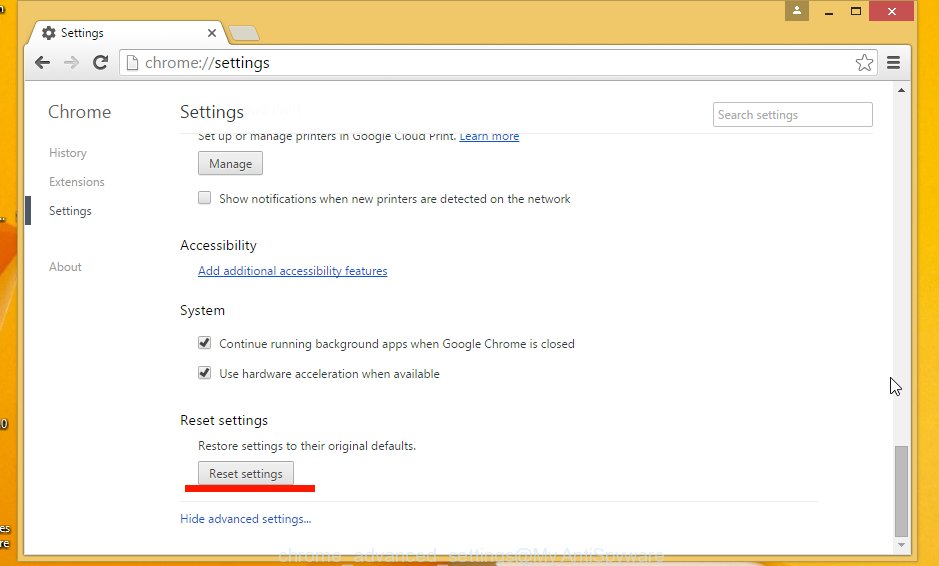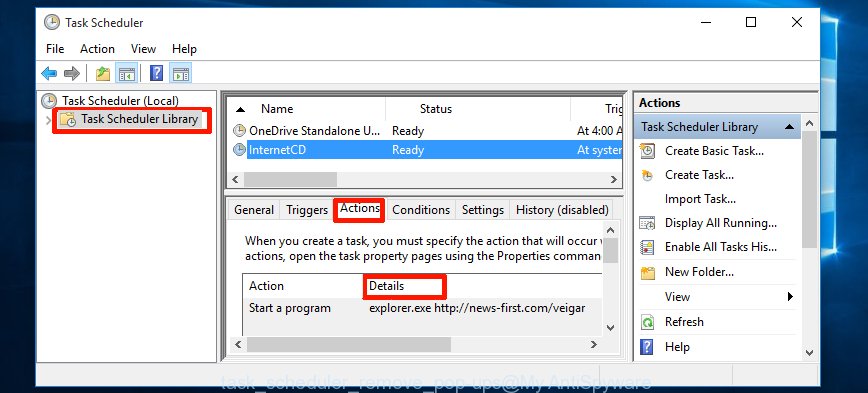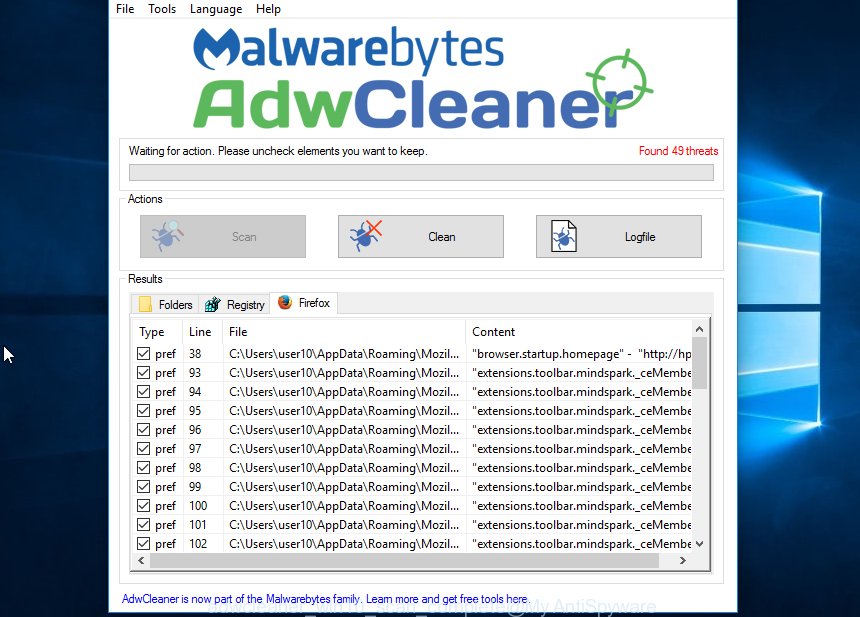If you’re reading this post, it means that you are seeing the find-journal.org unknown web page and your web-browser began opening lots of ads. All of these problems with your PC system caused by adware (sometimes called ‘ad-supported’ software), which is often installs on the machine with the free software. You probably want to know how to get rid of this adware as well as remove find-journal.org pop-up ads. In the few simple steps below we will tell you about how to solve your problems.
The ‘ad-supported’ software can change the settings of the Google Chrome, Internet Explorer, FF and Edge, but often that a malicious software like this can also infect all types of internet browsers by changing their desktop shortcuts. Thus forcing the user each time open the browser to see find-journal.org annoying ads.
The adware is not a virus, but the virus behaves similarly. As a rootkit hides in the system, modifies internet browser settings and blocks them from changing. Also the adware can install additional browser extensions, addons and modules that will inject advertisements within the Chrome, Mozilla Firefox, Microsoft Edge and Internet Explorer’s screen. Moreover, the ad-supported software may install a browser hijacker that once started, will change the web browser’s homepage and search engine. And finally, the adware can collect a wide variety of personal information such as what sites you are opening, what you are looking for the Internet and so on. This information, in the future, may be transferred to third parties.
We recommend to delete the ‘ad-supported’ software, which redirects your web-browser on the find-journal.org annoying web-site, as soon as you found this problem, as it can direct you to web-resources which may load other dangerous software on your machine.
How does find-journal.org ads get installed onto machine
Most often, the freeware installer includes the optional potentially unwanted applications such as this ad-supported software. So, be very careful when you agree to install anything. The best way is to choose the Custom, Advanced or Manual install mode. Here disable (uncheck) all optional applications in which you are unsure or that causes even a slightest suspicion. The main thing you should remember, you do not need to install the optional applications which you do not trust! The only thing I want to add. Once the freeware is installed, if you {aninstall} this software, the adware will not be removed. This must be done by yourself. Just follow the steps below.
How to manually remove find-journal.org redirect
This useful removal guide for the find-journal.org advertisements. The detailed procedure can be followed by anyone as it really does take you step-by-step. If you follow this process to delete find-journal.org let us know how you managed by sending us your comments please.
- Remove suspicious and unknown software by using Windows Control Panel
- Remove find-journal.org advertisements from Google Chrome
- Remove find-journal.org pop-up ads from FF
- Remove find-journal.org from Microsoft Internet Explorer
- Disinfect the browser’s shortcuts to get rid of find-journal.org redirect
- Remove unwanted Scheduled Tasks
Uninstall suspicious and unknown software by using Windows Control Panel
Press Windows key ![]() , then click Search
, then click Search ![]() . Type “Control panel”and press Enter. If you using Windows XP or Windows 7, then press “Start” and select “Control Panel”. It’ll open the Windows Control Panel as shown in the figure below.
. Type “Control panel”and press Enter. If you using Windows XP or Windows 7, then press “Start” and select “Control Panel”. It’ll open the Windows Control Panel as shown in the figure below. 
Next, press “Uninstall a program” ![]() It will show a list of all software. Scroll through the all list and remove any suspicious and unknown applications.
It will show a list of all software. Scroll through the all list and remove any suspicious and unknown applications.
Remove find-journal.org advertisements from Google Chrome
Open the Google Chrome menu by clicking on the button in the form of three horizontal stripes (![]() ). It opens the drop-down menu. Next, click the “Settings” option.
). It opens the drop-down menu. Next, click the “Settings” option.

Scroll down to the bottom of the page and click on the “Show advanced settings” link. Now scroll down until the Reset settings section is visible, as on the image below and click the “Reset settings” button.

Confirm your action, click the “Reset” button.
Remove find-journal.org pop-up ads from FF
First, start the Firefox. Next, press the button in the form of three horizontal stripes (![]() ). It will open the drop-down menu. Next, click the “Help” button (
). It will open the drop-down menu. Next, click the “Help” button (![]() ).
).

In the Help menu, press the “Troubleshooting Information”. In the upper-right corner of the “Troubleshooting Information” page, click “Refresh Firefox” button.

Confirm your action, click the “Refresh Firefox”.
Remove find-journal.org from Microsoft Internet Explorer
First, start the Internet Explorer, then press ![]() button. Next, click “Internet Options” as shown on the screen below.
button. Next, click “Internet Options” as shown on the screen below.

In the “Internet Options” screen select the Advanced tab. Next, click the “Reset” button. The IE will show the “Reset Internet Explorer” settings dialog box. Select the “Delete personal settings” check box and press Reset button.

You will now need to restart your machine for the changes to take effect. It will restore the Microsoft Internet Explorer’s settings such as homepage, new tab page and search engine by default to default state, disable ad-supported browser’s extensions and thereby delete the redirect to find-journal.org annoying web page.
Disinfect the browser’s shortcuts to get rid of find-journal.org redirect
Now you need to clean up the internet browser shortcuts. Check that the shortcut referring to the right exe-file of the internet browser, and not on any unknown file. Right click to a desktop shortcut for your web browser. Choose the “Properties” option.
It will display the Properties window. Select the “Shortcut” tab here, after that, look at the “Target” field. The ad supported software can replace it. If you are seeing something such as “…exe http://web.site.address” then you need to remove “http…” and leave only, depending on the browser you are using:
- Google Chrome: chrome.exe
- Opera: opera.exe
- Firefox: firefox.exe
- Internet Explorer: iexplore.exe
Look at the example on the screen below.

Once is finished, press the “OK” button to save the changes. Please repeat this step for internet browser shortcuts that redirects to an annoying web-pages. When you have completed, go to next step.
Remove unwanted Scheduled Tasks
Once installed, the ‘ad-supported’ software can add a task in to the Windows Task Scheduler Library. Due to this, every time when you start your computer, it will open find-journal.org annoying page. So, you need to check the Task Scheduler Library and get rid of all tasks that have been created by malicious programs.
Press Windows and R keys on your keyboard together. It will display a prompt that titled with Run. In the text field, type “taskschd.msc” (without the quotes) and click OK. Task Scheduler window opens. In the left-hand side, click “Task Scheduler Library”, as shown on the screen below.

Task scheduler, list of tasks
In the middle part you will see a list of installed tasks. Select the first task, its properties will be open just below automatically. Next, click the Actions tab. Necessary to look at the text which is written under Details. Found something like “explorer.exe http://site.address” or “chrome.exe http://site.address” or “firefox.exe http://site.address”, then you need get rid of this task. If you are not sure that executes the task, then google it. If it is a component of the ‘ad-supported’ applications, then this task also should be removed.
Further press on it with the right mouse button and select Delete as shown on the screen below.

Task scheduler, delete a task
Repeat this step, if you have found a few tasks that have been created by ‘ad-supported’ application. Once is finished, close the Task Scheduler window.
How to remove find-journal.org pop-up ads with free malware remover
Remove find-journal.org advertisements manually is difficult and often the ad-supported software is not completely removed. Therefore, we recommend you to use the Malwarebytes Free which are completely clean your PC. Moreover, the free program will help you to remove malware, web browser hijacker and toolbars that your PC may be infected too.
- Download Malwarebytes from the link below. Malwarebytes Anti-malware
327070 downloads
Author: Malwarebytes
Category: Security tools
Update: April 15, 2020
- Close all software and windows on your machine. Open the directory in which you saved it. Double-click on the icon that’s named mb3-setup.
- This will launch the setup of Malwarebytes. Next, press Next button and follow the prompts.
- When installation is done, click on the “Scan Now” button to begin checking your personal computer for the ‘ad-supported’ software which redirects your internet browser to the find-journal.org unwanted web-page. This process can take some time, so please be patient.
- When it has finished scanning your machine, make sure all entries have “checkmark” and click “Quarantine Selected”. When the disinfection is finished, you may be prompted to restart your PC system.
These steps above are shown in detail in the following video guide.
How to block find-journal.org
To increase your security and protect your PC system against new annoying ads and malicious web sites, you need to use an application that blocks access to malicious ads and web pages. Moreover, the program can block the show of intrusive advertising, that also leads to faster loading of web sites and reduce the consumption of web traffic.
- Download AdGuard application from the following link.
Adguard download
26842 downloads
Version: 6.4
Author: © Adguard
Category: Security tools
Update: November 15, 2018
- Once downloading is finished, run the downloaded file. You will see the “Setup Wizard” window. Follow the prompts.
- When the install is finished, click “Skip” to close it and use the default settings, or press “Get Started” to see a quick tutorial that will help you get to know AdGuard better.
- In most cases, the default settings are enough and you do not need to change anything. Each time, when you run your machine, AdGuard will start automatically and block advertisements, find-journal.org redirects, as well as other dangerous or misleading web-pages. For an overview of all the features of the program, or to change its settings you can simply double-click on the AdGuard icon, which is located on your Windows desktop.
Scan your computer and delete find-journal.org redirect with AdwCleaner.
This removal program is free and easy to use. It can scan and get rid of ‘ad-supported’ software (also known as adware), browser hijackers, malware and unwanted toolbars in Google Chrome, Firefox, IE and MS Edge web-browsers and thereby restore back their default settings (homepage, new tab page and search engine by default). AdwCleaner is powerful enough to find and delete malicious registry entries and files that are hidden on the PC.
Download AdwCleaner tool from the link below. Save it to your Desktop so that you can access the file easily.
225545 downloads
Version: 8.4.1
Author: Xplode, MalwareBytes
Category: Security tools
Update: October 5, 2024
Once the download is finished, open the directory in which you saved it and double-click the AdwCleaner icon. It will start the AdwCleaner tool and you will see a screen as shown in the figure below. If the User Account Control dialog box will ask you want to display the program, click Yes button to continue.

Now, click the “Scan” for scanning your system for the ‘ad-supported’ software which cause a redirect to find-journal.org ads.

When the system scan is finished, it will display a list of all items detected by this utility as shown on the image below.

You need to press “Clean” button. It will show a prompt, click “OK” to begin the cleaning procedure. Once the clean-up is finished, the AdwCleaner may ask you to restart your system. After restart, the AdwCleaner will show the log file.
All the above steps are shown in detail in the following video guide.
Finish words
Once you have finished the step-by-step guide above, your PC system should be free from malware and ad-supported software. The Chrome, Microsoft Internet Explorer, Mozilla Firefox and Microsoft Edge will no longer open find-journal.org unwanted popup ads or redirect you to unwanted web-pages. Unfortunately, if the steps does not help you, then you have caught a new type of adware, and then the best way – ask for help in our Spyware/Malware removal forum.

















